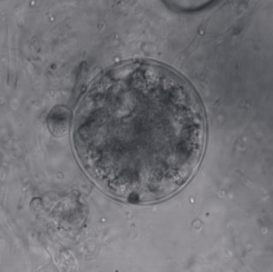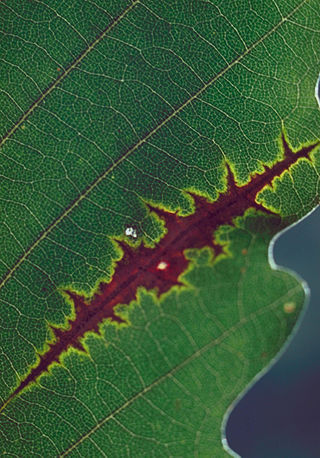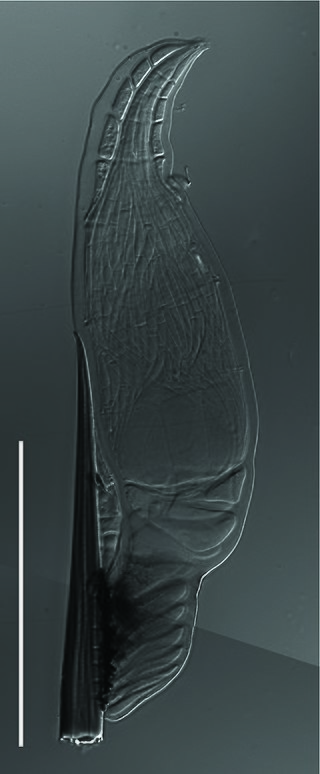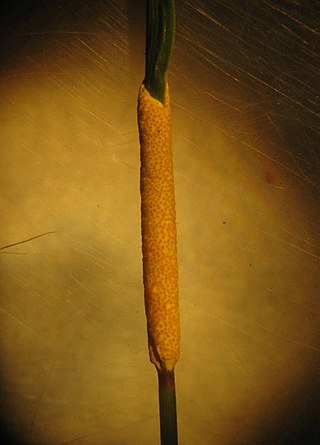
Chytridiomycota are a division of zoosporic organisms in the kingdom Fungi, informally known as chytrids. The name is derived from the Ancient Greek χυτρίδιον, meaning "little pot", describing the structure containing unreleased zoöspores. Chytrids are one of the earliest diverging fungal lineages, and their membership in kingdom Fungi is demonstrated with chitin cell walls, a posterior whiplash flagellum, absorptive nutrition, use of glycogen as an energy storage compound, and synthesis of lysine by the α-amino adipic acid (AAA) pathway.

The Laboulbeniomycetes are a unique group of fungi that are obligatorily associated with arthropods, either as external parasites or for dispersal (Pyxidiophorales).

The order Sordariales is one of the most diverse taxonomic groups within the Sordariomycetes.

The Laboulbeniales is an order of Fungi within the class Laboulbeniomycetes. They are also known by the colloquial name beetle hangers or labouls. The order includes around 2,325 species of obligate insect ectoparasites that produce cellular thalli from two-celled ascospores. Of the described Laboulbeniales, Weir and Hammond 1997 find 80% to be from Coleoptera and the next largest group to be the 10% from Diptera. Recently, the genus Herpomyces, traditionally considered a basal member of Laboulbeniales, was transferred to the order Herpomycetales based on molecular phylogenetic data. Laboulbeniales typically do not kill their hosts, although they may impair host fitness if the parasite density is high.

Apiognomonia errabunda is a fungal plant pathogen and causal agent of oak anthracnose. It is one of the most widespread leaf-associated fungi in the northern temperate zone and is found mostly on oak, beech, and linden trees.

The Arthoniales is the second largest order of mainly crustose lichens, but fruticose lichens are present as well. The order contains around 1500 species, while the largest order with lichenized fungi, the Lecanorales, contains more than 14000 species.

The Orbiliaceae are a family of saprobic sac fungi in the order Orbiliales. The family, first described by John Axel Nannfeldt in 1932, contains 288 species in 12 genera. Members of this family have a widespread distribution, but are more prevalent in temperate regions. Some species in the Orbiliaceae are carnivorous fungi, and have evolved a number of specialized mechanisms to trap nematodes.

Meruliopsis is a genus of poroid crust fungi. The genus was circumscribed by Russian mycologist Appollinaris Semenovich Bondartsev in 1959.
Gloeandromyces is a genus of fungi in the family Laboulbeniaceae. The genus contains five species. All species are associated with Neotropical bat flies.

Hesperomyces is a genus of fungi in the family Laboulbeniaceae. The genus contains ten species, including the type species, the Green Beetle Hanger. H. virescens is a complex of species. It is an ecoparasite of an invasive species to Europe and the Americas, the harlequin ladybird. Laboratory bioassays pointed out that Hesperomyces-infected ladybirds suffered increased mortality rates.

Polyozellus is a fungal genus in the family Thelephoraceae, a grouping of mushrooms known collectively as the leathery earthfans. Previously considered a monotypic genus, it now contains the Polyozellus multiplex species complex. The genus name is derived from the Greek poly meaning many, and oz, meaning branch. It is commonly known as the blue chanterelle, the clustered blue chanterelle, or, in Alaska, the black chanterelle. The distinctive fruit body of this species comprises blue- to purple-colored clusters of vase- or spoon-shaped caps with veiny wrinkles on the undersurface that run down the length of the stem.

Rickia wasmannii is a species of the widely distributed entomoparasitic order of fungi Laboulbeniales. It is an obligatory ectoparasite of ants of the genus Myrmica. The thalli penetrate outer layer of the cuticle, and appear on the host body surface. Little is known about its effect on the host ant, but it is usually regarded as a rather neutral symbiont. Contrarily, however, a recent study has documented an increased need of drinking water and a shortened life-span of infected ants.
Sulzbacheromyces is a genus of basidiolichens in the family Lepidostromataceae. The genus is distinguished from the other genera of Lepidostromataceae by having an entirely crustose thallus and from Multiclavula (Cantharellales) by having a chlorococcoid photobiont. The type species grows on soil in the neotropics.

Microglossum viride is a species of fungi in the family Geoglossaceae. They are commonly called green earth tongues.

Herpomyces is a fungal genus in the order Herpomycetales (Laboulbeniomycetes), with species that are exclusively ectoparasites of members of the Blattodea order (cockroaches). As of 2020, 27 species of Herpomyces are formally described. Members of Herpomyces have been reported from all continents except Antarctica.

Epichloë typhina is a haploid sexual species in the fungal genus Epichloë. It was originally described as a Sphaeria species. Today, however, it is classified in Epichloë.
Rhizopogon amylopogon is a sub-genus of Rhizopogon containing seven species.

Chester Wilson Emmons was an American scientist, who researched fungi that cause diseases. He was the first mycologist at the National Institutes of Health (NIH), where for 31 years he served as head of its Medical Mycology Section.
Zhurbenkoa is a genus of lichenicolous fungi in the family Malmideaceae. It has three species. The genus was circumscribed in 2019 by Adam Flakus, Javier Etayo, Sergio Pérez-Ortega, and Pamela Rodriguez-Flakus, with Zhurbenkoa epicladonia assigned as the type species. Closely related genera are Savoronala and Sprucidea. The generic name honours Russian lichenologist Mikhail Zhurbenko, "for his magnificent contribution to knowledge on the biodiversity and systematics of lichenicolous fungi, including lichen parasites colonizing Cladonia".

Laboulbenia slackensis is a microscopic fungus found on Carabidae arthropods. Like all fungi found in the Laboulbeniomycetes class, L. slackensis is an obligate ectoparasite and lives its entire life cycle on one host. It is differentiated from other related species based on host preference, and is studied as an example of speciation due to ecological niche preference.















